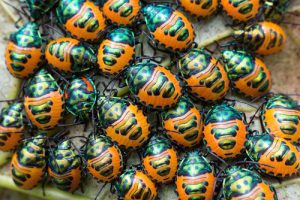What is an Insect Pheromone Trap?
By Chris Williams on April 12, 2012.
Q. Can you explain to me what pheromone traps are and how they work? My sister-in-law said that her pest control company used them when she had a beetle problem in her kitchen.
A. Pheromones are natural scents that insects use to communicate and to find each other. Scientists have found ways to duplicate insect pheromones and incorporate them into lures that are used in traps. The pheromones commonly used are either aggregation pheromones or sex attractant lures that mimic the female’s scent to draw the male insect into the trap. Some traps also have an added food attractant but they do not contain any insecticide.
 There are pheromone traps available for many different household pests, including clothes moths, carpet beetles, cockroaches, and various stored food pests like flour beetles and Indianmeal moths. Many pheromone traps contain the pheromone only for a particular pest and won’t attract others, while other traps include pheromones for more than one type of pest. Make sure your problem pest is listed on any trap you purchase.
There are pheromone traps available for many different household pests, including clothes moths, carpet beetles, cockroaches, and various stored food pests like flour beetles and Indianmeal moths. Many pheromone traps contain the pheromone only for a particular pest and won’t attract others, while other traps include pheromones for more than one type of pest. Make sure your problem pest is listed on any trap you purchase.
Pest control professionals use pheromone traps mostly as monitoring tools. Keeping pheromone traps in place in places like grocery stores or food warehouses alerts the technician to a new infestation before it can get out of control. Pheromone traps also tell the professional whether his control methods were effective by capturing any “stragglers” that might remain after treatment.
In a home, you could place pheromone traps in areas where you have seen the pests or in areas where there are high-risk items that you want to protect. For example, say you’ve had a problem in the past with Indianmeal moths in foods in your kitchen pantry. For your peace of mind, checking a grain moth pheromone trap kept in that pantry would tell you if the moths return. Or, maybe you have a couple of fur coats stored in a closet in the upstairs guest bedroom. A clothes moth pheromone trap in the bedroom would act as an early warning system to help protect your coats.
Professional traps are made up of a basic trap body to which various lures are added that are specific for the insects to be trapped. Hanging traps for flying insects capture the insects on a sticky board insert. Traps for crawling insects sit on a surface and often have an oil pit in the center that attracts and drowns insects. Pheromone traps sold to consumers usually come with the pheromone lure already incorporated into the trap.
Don’t place pheromone traps near an open window or door where they could lure insects in from outside. Don’t place traps where children could reach them. Pheromone lures will eventually lose their effectiveness and will need to be replaced.
Pheromone traps are primarily monitoring devices and are not designed to eliminate an infestation of pests. Aggregation pheromone traps attract both sexes, but not every single insect is going to be attracted to, and end up captured in, your pheromone traps. Traps that attract only male insects will eventually put a dent in the pest population but are certainly not going to get rid of the infestation any time soon. If you have a serious pest infestation going on, don’t expect to get rid of it by using pheromone traps. Contact a pest management professional.